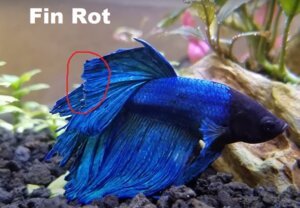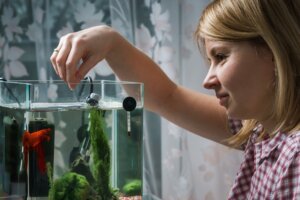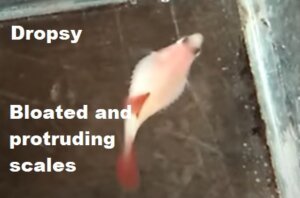The life of a betta fish can be full of many ups and downs. One moment they’re swimming happily along in their tank; the next, they’re laying on the bottom of the tank, looking sad as if to say, “I’m done with this”. It’s not uncommon to see Betta Fish Lying at Bottom of Tank, but there are some things you can do to help them out.
Betta fish make up some of the most common freshwater fish in aquariums. They are easily purchased from any local pet shop, and due to their colorful scales, they’re a popular addition to any fish tank.
However, one common problem that many betta owners come across is the fact that their fish may prefer laying on the bottom of the tank rather than swimming around.
This article covers some of the common reasons you might find your betta fish lying at bottom of tank.
Fish Diseases Causing Your Betta Fish Lying at Bottom of Tank

Ammonia Poisoning
Feces, urine, and tissue excreta from fish and other organic matter are broken down into nitrogenous compounds, commonly leading to ammonia poisoning.
This ammonia poisoning, in turn, can lead to your Betta Fish Lying at Bottom of Tank. In a fish tank with biological filtration and up-to-date maintenance, this problem does not occur.
Temperature and chemical parameters can help or worsen the toxic ammonia outbreak. To avoid this, keep your tank clean, avoid over-feeding, and invest in a good filter. Perform extensive water changes whenever you can to help your betta.
 Top Top | Heals damaged fins & skin, Bacterial infections, contains melaleuca | View on AMAZON | |
 Top Top | Anti-fungal, Internal & external infections | View on AMAZON | |
 Top Top | Parasitic disease (gill, & skin flukes), Swolen abdomen, Hole-in-head, Wasting disease | View on AMAZON | |
 Top Top | Treats most diseases- Ick, Fungus, Mouth rot, Use as a preventative | View on AMAZON | |
| Fungal Infections | View on AMAZON | ||
 Top Top | Fungal & Bacterial- Dropsy, Popeye, Fin/tail rot, Septicaemia; Treats internal when food is refused | View on AMAZON | |
 Top Top | Nematodes, Roundworm, Nodular worm, Hookworm | View on AMAZON | |
 Top Top | Micro-bacterial starter- Establishes nitrifying bacteria. This cylces your tank and reduces ammonia and nitrates | View on AMAZON |
Nitrate Poisoning
Betta fish with nitrate poisoning may breathe heavily and appear pale – either gray or brown. Other symptoms include loss of appetite, rapid gill movement, acting dazed and confused, disorientation, and laying at the bottom of the tank.
Verify that water contains a high-level nitrate by using a proper test. If the nitrate concentration is too high, perform a significant water change and add cycled media to the tank.
Fungal Infection
Fungal infections tend to be contagious and could easily infect other inhabitants of the tank. Infections of this type are usually a symptom of something wrong in the tank, usually bad water conditions.
This causes a drop in the immune system of the betta fish and an entry to harmful fungi and bacteria. To treat a fungal infection, ensure that the betta fish has perfect water parameters and conditions, and consider using an anti-fungal medication.
Salt baths are often a helpful complement to this treatment to prevent Betta Fish Lying at Bottom of Tank.
Betta Fish Tail or Fin Rot

Betta fish fin rot is a bacterial infection caused by Pseudomonas bacteria. The infection causes soreness and inflammation to the betta fin tissue, leading to decay and deterioration of the affected parts.
Like fungal infections, this fin rot is a symptom of a problem in the tank, usually with the water conditions. Thus, fin rot is mostly seen among long-finned or show-quality betta fish with poor water quality, aren’t fed appropriately for their size, or are otherwise under stress.
This disease can be very serious if left untreated, as it can spread into other areas of the body (such as your fish’s gills) if not caught early on. To make matters worse, when you notice the decaying fins, the disease has already reached an advanced stage.
Make sure to maintain ideal water parameters and change the water regularly. Pet stores have medications for these conditions. There are also natural remedies you can try at home as a compliment.
Treating this will help prevent the Betta Fish Lying at Bottom of Tank.
Betta Fish Fin Rot Symptoms And Treatment

There are several stages with betta fin rot. First, the betta fish becomes apathetic and loses appetite, then starts to hang around the bottom, and its fins will turn white at the ends.
As symptoms develop, the fins start to melt away, and the rot accelerates toward the body. Your betta fish could lose some of its ability to swim and end up landing on the substrate. At this point, the disease has reached a very advanced stage and is likely fatal.
How to Treat Betta Fish Fin Rot Naturally
Remove Infected Fish
Remove your fish from the aquarium and place it in a QT tank or bowl with the same water conditions as your main tank. If you have other fish, place them in a QT tank too.
Do not let the sick betta come into contact with healthy fish since this is an infectious and transmissible disease. Add some aquarium salt to reduce stress on your fish during its recovery period.
Treatments such as Kanamycin (or another antibiotic) are very harmful to the environment, so try treating naturally first before resorting to medications.
If noticed early enough, the disease can be controlled by feeding and constant water change. If you are treating your fish with medications, follow all directions carefully and do not over-medicate.
Aquarium Treatment
Treat the aquarium with a natural remedy like BettaZing or Bettafix to eradicate Pseudomonas bacteria. This will help prevent the disease from spreading while you work on getting rid of it in your sick betta fish.
To kill off any bacteria, you can also add some essential oils to the tank-like peppermint, lemongrass, rosemary, or tea tree. Make sure to control the water conditions, as these remedies will be rendered ineffective by improper conditions.
Fish Treatment
Apply a home remedy such as Melafix on the affected fins every 12 hours (or according to directions). The medication will reduce inflammation and help damaged tissues heal faster. You can also maintain a 0.3% salinity to soak the fish’s fins for an added boost to aid in the healing process.
Clean the Tank

Remove any uneaten food from your betta’s bowl daily so that it does not pollute the water with bacteria. Clean contents of bowl or QT tank completely once you notice fin rot symptoms appear again. Make sure to have a maintenance routine to keep everything consistently in order.
Good Food
Offer your fish a nutritional diet full of protein and Omega-3 fatty acids like Spectrum pellets, blood worms, or brine shrimp. Fresh veggies such as green beans are also beneficial to helping your betta recover from this disease. Food variety and quality is the secret to speeding up the healing process.
Quarantine New Fish
Isolate any new bettas that you add to the aquarium if they bring their own internal bacterial infections. It’s always a good idea to quarantine newly acquired fish before placing them in the main tank.
Betta Fish Fin Rot Prevention
Clean your aquarium thoroughly
This will ensure that you’re starting off with a clean tank for when you get your new betta fish. Also, be sure to use a good quarantine method so that any diseases that new fish might be carrying are not transferred to your other fish during this process.
Change 20-30% of the water every week
It is important for the health of all living things in your aquarium to change the water regularly. This will help remove any excess waste and keep everything running smoothly. Use a gravel cleaner to suck out the waste and other debris that has settled into the bottom of your tank. Pay special attention to decorations where waste can be trapped.
Don’t overfeed your fish. If the filtration system is not up for it, and you do not keep up with maintenance, overfeeding will lead to bacterial build-up in the tank, which is not good for the fish.
Additionally, do not feed fish expired food, as it can carry pathogens and will not provide adequate nutrition, depressing the fish’s immune system.
Keep water condition up
Make sure you keep your water’s ammonia and nitrates down with weekly water changes. Don’t overcrowd the tank. Overcrowding stresses the fish and causes rapid deterioration of water quality, both of which are dangerous for the fish.
Betta Fish Swim Bladder Disorder
The swim bladder disease is any condition in which fish will never properly float or fall while swimming. This condition alters the swim bladder that provides betta fish with buoyancy underwater.
In medical terms, the fish is suffering from both positive and negative buoyancy.
Swim bladder disorder can be caused by a number of issues, including digestive problems, genetics, and physical trauma.
Symptoms and Treatment for Swim Bladder Disorder
Swim bladder disorders have traditionally occurred in adult betta fish. The principal danger factor is weight. Fish can often live long periods of time with the swim bladder disorder as long as they can properly feed themselves and do not have any other medical problems, depending on the cause and stage of the disorder.
The disorder can be treated with Epsom salts and by piercing the bladder with a needle. Consult with a vet who could give you advice.
Swim Bladder Disease
Swim bladder disease has often been the result of improper feeding. To protect and improve the health of fish with swimming bladder disease, give them small slices of blanched green pea fronds or daphnia.
When the fish recovers, it should return to swimming in a normal manner. Epsom salts and piercing the bladder with a needle are effective treatments for swim bladder disease. This treatment may help prevent the Betta Fish Lying at Bottom of Tank.
Ich (white spot disease)

Ich (Ichthyophthirius multiplefiliis) is a protozoan and exists in many aquariums and ponds. A healthy fish’s antimicrobial response wards off ich.
A stressed fish, however, is more susceptible to ich. Infrequent water changes, improper water temperatures, and poor diet can severely weaken a fish’s immune system.
In fact, one of the main triggers of this disease is the fluctuation of physical water parameters. For treatment, quarantine your betta in another tank and raise the temperature to approximately 84° F for 14 hours.
This will break the parasite’s reproductive cycle, eradicating the ich. In cases of serious infestation, medication can be used.
Ich Symptoms and Treatment
The first signs of trouble are small white dots that appear on the head in an overnight pattern around your Betta’s gills, body, and/or fins. Fish may later have skin ulcers.
Aside from the white dots, other signs of the disease are haemorrhages and subsequent bacterial and fungal invasion, weight loss, and excessive mucus production.
Quarantining fish is an important prevention method. When one fish becomes infected, begin treating the entire tank.
Betta Fish Lying at Bottom of Tank Due to Old Age
Old bettas have more of a tendency for slowing down. Most older fish prefer resting more. They may begin to lie down on leaves or rest on the bottom of the tank.
Constipation
If your Betta fish is kept in cold water, its heart rate, growth speed, immune response, and digestion start dropping. Bloating is often mistaken for swimming bladder illness resulting in bladder infection in some patients. Warming up as soon as possible and properly feeding will keep the fish healthy.
Popeye

Popeye is a symptom of an aggravated bacterial infection on your betta fish. The main symptom is a protruding, swollen, and strange-looking eye due to excess fluid in the eye sockets, which exert pressure and force the eye to protrude more than normal.
A whitish color around the eye is another common sign. Treatment for any injured or sick fish depends on the circumstances. You should remove your fish from its tank and administer ampicillin and aquarium salt to the aquarium.
Cold Temperatures
Betta fish are tropical fish found in small canals in Thailand where water temperatures seldom lower than 73-75°F. If you use the mini heater in the betta’s basket or tank, you can see immediate change. It should perk up quickly more, eat more and be less prone to illness and lethargy.
It’s better to see it around 25-30° C degrees! Use a heater to warm up your jug or pot and help your fish’s appetite.
Filter Current Is Too fast
Large fins make swimming in turbulent waters much complicated. Betta fish prefer slower water flows. If your betta appears less active and enjoys sitting on the bottom of its tank, adjust the filter’s water flow in this manner.
You could possibly use a low-cost sponge filter for smaller fish tanks measuring around 3 to 5-gram volumes.
For larger tanks, including larger fishes such as bettas and other small-scale community fish with large bodies, a good option is the AquaClear Power Filter 50. Tank divider sets are cheap and provide you the perfect flow baffle and attachment points on the baffle.
Low Dissolved Oxygen
Unlike most fish, betta fish, and her cousins, the Gouramis have a specialized organ called the labyrinth organ. This allows them to breathe directly from the atmosphere as we get extra oxygen from the gills.
In the still, hot weed-choked waters of their native Thailand, they can thrive where other fish would suffocate for lack of oxygen present. The anaerobic bacteria release harmful substances that inhibit them, like hydrogen sulfide, if there is no oxygen in their system, preventing their growth. Thus, oxygenation is very beneficial for bettas.
Water Too Hot
Oxygen becomes less soluble at higher water temperatures. Without oxygen, betta fish will gulp for air below the tanks. Even as they breathe atmospheric air, it is important that they never lose access to adequate oxygen. Cool down your tank’s temperatures slowly with a fan or room air conditioner.
Use an air bladder to infuse oxygen into your water quickly. Another option is to use thermal insulation so the temperature in the aquarium remains stable.
Water Too Cold
Bettas thrive well in waters 25-30° C. For heaters, 1.5-2 W per liter works well for places with very low temperatures, whereas in milder places, 0.5 W per liter will do the job.
Small Aquarium Size
If the fish seems restricted then, you are in need of choosing a larger aquarium. Bettas enjoy swimming in a horizontal place such as shallow rice fields with a nice hideout space.
Confined environments result in lazy and lethargic betta fish; it also stresses the fish and shortens their lifespan. A 10 or 20-gallon tank with a filter is ideal for keeping betta fish healthy and well.
You can also add more fish to larger tanks than just bettas, as long as they are calm fish and there are plenty of hiding places.
Treating a sick Betta Fish
When quarantining fish, remove any plants from the quarantine tank. This will keep the medication from damaging plants.
Sleeping Betta Fish
A betta with a good appetite often takes naps. If you aren’t sure whether your betta is simply tired, observe the fish closely for a few days and watch for any signs of stress or illness.
Bettas sleep at night in the dark. Bettas usually sleep in the dark, so lying on the bottom in the light is likely not sleeping.
What can you do to help your betta fish lying at bottom of tank who is sick?
Keep a betta first-aid kit; having betta medications on hand is smart because pet stores often do not contain betta-specific medications or may be out of stock. Salt and clean water are the go-to treatments for many illnesses that bettas may have.
Other stress-related issues
By you see a betta fish floating on its side, watch it closely. If the tank is too narrow, provide a larger area. If you are unsure if this fish has microbial smears, watch very carefully and look for signs and symptoms along its length. It is also important to maintain the water temperature in the correct range.
Dropsy

Dropsy is a syndrome generated by a serious infection. Common symptoms are belly swelling, injuries to gills and intestines, bristly scales, listlessness, undulating swimming, and difficulty breathing due to tot the impediment of the free movement of the diaphragm.
Temperature balance is essential to maintain the fish’s immunity. Avoid high stocking of fish in the tank, and avoid overfeeding; excess feces and urine in the water give the opportunity for pathological bacteria to develop.
Betta hiding in the tank’s corner
Betta fish like hiding in the structure to feel secure. This often indicates stress and poor acclimation to the aquarium. Having other fish in the tank can help, including loaches, plecos, some livebearers with smaller and less colorful tails, corydoras, and others.
The fish also hide around the corner when the current is stronger than necessary. Fish also might hide in the corner when the current is too strong.
Wrapping up – Betta Fish Lying at Bottom of Tank
You have to know about your Betta Fish Lying at Bottom of Tank in order to help them. Please share this guide in order to help other aquarists become as informed as possible. It is our goal to encourage as many as possible to become informed and responsible betta owners!

